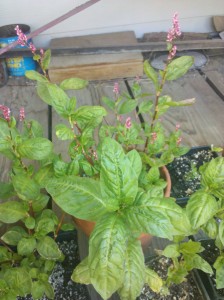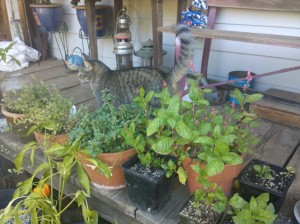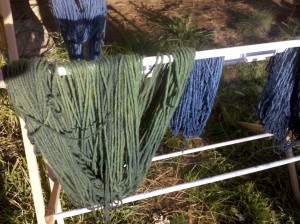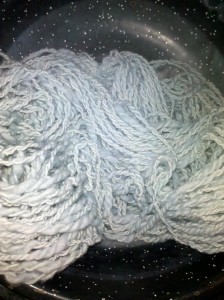The Magic of Blue
When I started this CSA Farm adventure, I planned to grow enough Japanese Indigo (Polygonum tintorium) to dye yarns for my subscribers; after all, the plant grew well in other parts of California and normally, we have a wonderful growing season here in the foothills. Nature, and the seeds I got originally, had other plans for me. The spring was cold and wet. The first round of seeds withered and died, the 25% that even bothered to germinate!
Thanks to Dustin, I was able to get another batch of seeds going, but I didn’t have real plants until early August.
Well, unfortunately, the days are already getting shorter by August, and by the time I was ready to transplant the seedlings, I opted for large pots instead of putting them in the ground.
They could be moved around to take advantage of the best sun, and I even ended up bringing them indoors in late October, protecting them from an unusual early snow! All that babying kept them growing, though far slower than if they had gotten a proper start.
It was clearly obvious that my paltry Japanese Indigo garden was not going to produce enough mass to dye yarns for my shareholders, as planned. Around the same time, I decided to start an instant indigo vat with pre-reduced indigo crystals from the Indigofera tinctoriaplant (sub-tropical ‘true’ indigo), in order to tie-dye shirts for the children in our early childhood program. We had just gone on a field trip to the Pumpkin Patch, where we were surrounded by swarms of children, mostly other peoples’, and realized that readily identifiable shirts for such occasions would be a real blessing.
I was so excited by our results that I quickly dyed up a bunch of yarns, in awe of the oxidation transformation each and every time.
It only took 30 seconds to a few minutes of submersion in the vat to soak up enough dye for good coloration, though I was running around trying to keep from dripping, cleaning up after myself as I ferried the yarns outdoors to drip and dry. I managed to dye the blue yarns I needed for my Sky Scarf project, and get a few pounds done to package up and sell.
I also ordered enough supplies to put together indigo vat kits for my CSA shareholders. While I was a bit uncomfortable about going afield from my original intentions for a local-only CSA, I decided it was better to share the magic of blue in a different way than I had originally planned, so that I could honor my commitment to those good charter supporters who helped me launch my farm.
Meanwhile, my potted Japanese indigo garden was being ferried in and out of the house, depending upon the weather, and managed to keep going, though as most plants look around here in November, not at its finest. There were flowers but the stems were getting spindly. I couldn’t locate the chemicals that my recipes called for. Then, one of the members of our online “Found, Stitched, Dyed” forum posted about using vinegar to process her Japanese indigo plants, with beautiful results. I decided to try her detailed explanation, since my plants needed to be harvested… I found it was the hardest thing to cut off those first few stems, after begging and cajoling and pampering these plants! I chopped up my plants with the blender, and the smell reminded me of wheatgrass juice.
I followed the instructions, using a jar to soak my strainer fabric and then a skein of handspun yarn, and was pleased with the results.
Very different from ‘true’ indigo, but a lovely blue, nonetheless!














Using vinegar is an approximation of “Saxon Blue” – a different process than the reduction/oxidation of the “normal” indigo vat. Trudy Van Stralen has a very complete chapter on it in her book “Indigo, Madder, Marigolds.”
I’ve never tried using plants, but have had good luck with the indigo extract from EarthHues, and the natural indigo from Dharma Trading. Dharma also sells all of the associated chemicals needed to prepare it.
I’m in awe of the depth of your color – It’s really beautiful!!